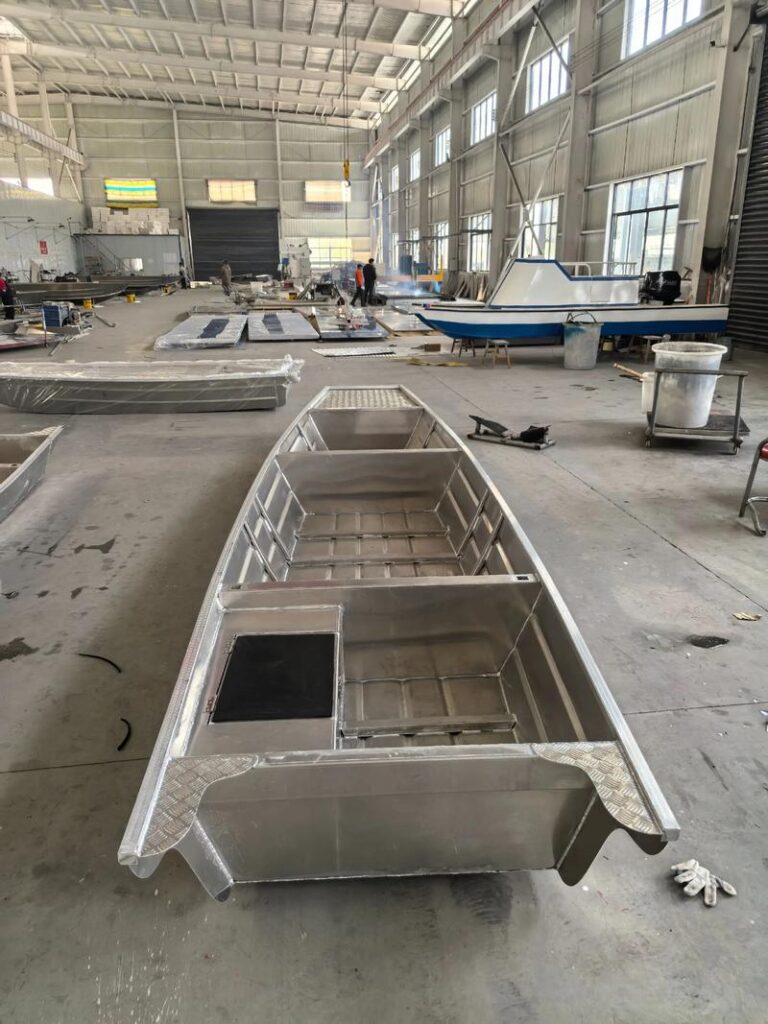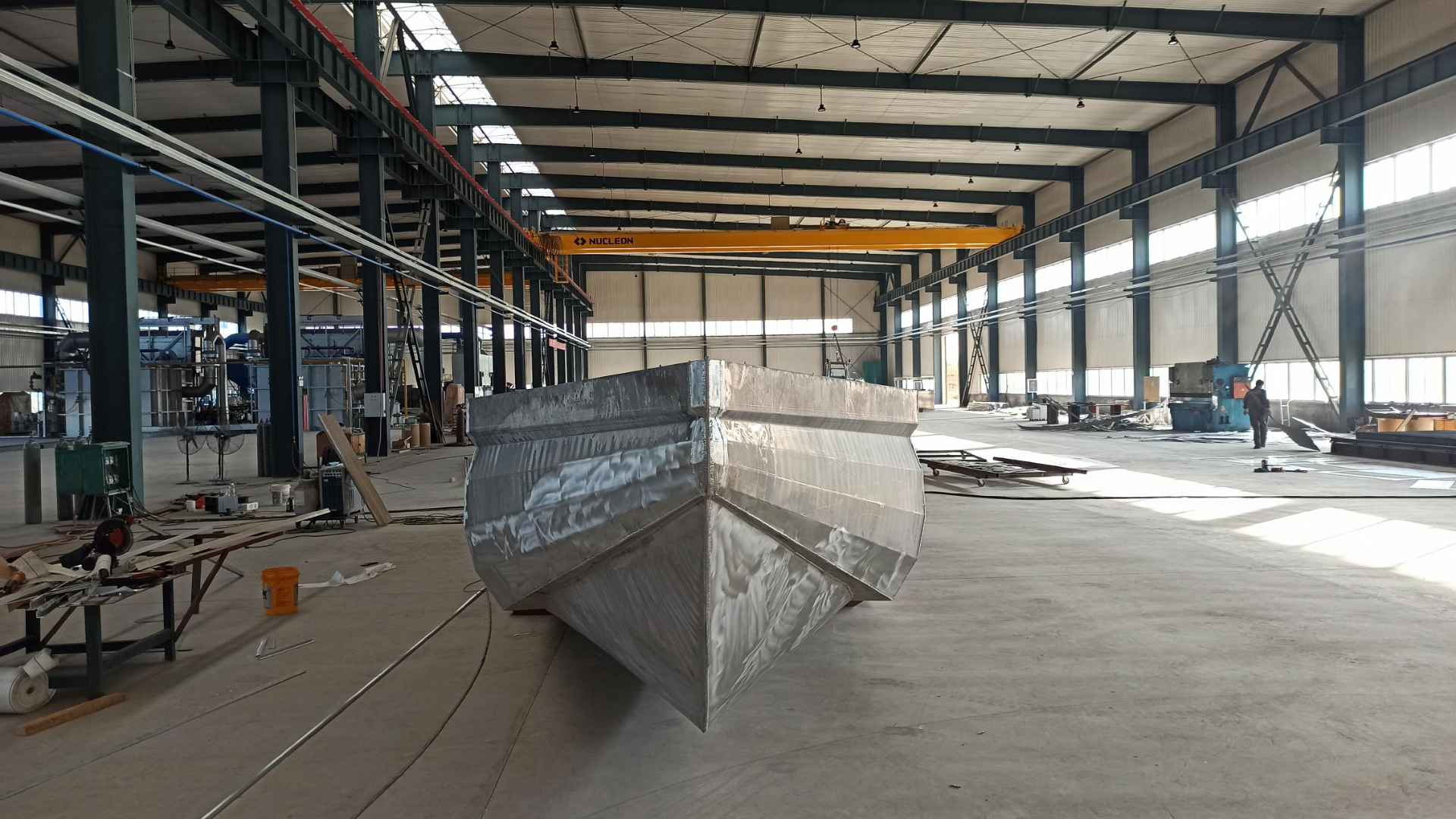Flat Bottom vs V hull– Which Hull Design Is Right for Your Boat?
Choosing between a flat bottom vs V hull is one of the most important decisions when buying or designing a boat. Each hull type performs differently in speed, stability, comfort, and water conditions. Whether you’re navigating shallow inland waters or cutting through offshore waves, understanding how these two hull designs behave will help you make the right choice.
What Is a Flat Bottom Boat Hull?
A flat bottom hull features a nearly level underside with little to no deadrise angle. This design allows the boat to sit high on the water, providing:
- Excellent stability on calm waters
- Minimal draft — ideal for shallow areas and sandbanks
- Fast planing and good load distribution
Flat bottom hulls are commonly used for jon boats, utility boats, small fishing boats, and inland watercraft where calm water and shallow access are more important than wave-cutting performance.

What Is a V Hull Boat?
A V hull tapers down to a pronounced angle (deadrise), forming a “V” shape at the bottom. This structure allows the boat to cut through waves, offering:
- Smooth ride in choppy water
- Better directional control and offshore handling
- Improved performance at higher speeds
V hulls are preferred for offshore fishing boats, speedboats, patrol craft, and rough-water recreational vessels that require wave-piercing capability and better hydrodynamic efficiency.

Key Differences Between Flat Bottom and V Hull Boats
| Feature | Flat Bottom Hull | V Hull |
|---|---|---|
| Performance in Waves | Bumpy ride, slaps water surface | Cuts through waves for smoother ride |
| Stability at Rest | Very stable | Less stable when stationary |
| Speed in Calm Water | Quick to plane, efficient at low power | Higher speed potential with more power |
| Draft (Shallow Water Access) | Very shallow draft | Deeper draft, limited near shore |
| Fuel Efficiency | Efficient at low speeds | Efficient at medium to high speeds |
| Comfort | Stable on flat water, rough on waves | Comfortable in waves, less stable at rest |
| Typical Use | Inland lakes, rivers, calm water fishing | Offshore trips, open water cruising |
Advantages of Flat Bottom Hulls
Flat bottom boats offer specific benefits for inland and calm water boating:
- ✅ Ultra-shallow water capability — Perfect for creeks, marshes, and fishing spots near shore.
- ✅ High initial stability — Great for activities like standing fishing or survey work.
- ✅ Economical propulsion — Can operate efficiently with smaller outboard engines.
- ✅ Easy to build and maintain — Ideal for DIY or low-cost utility boats.
Advantages of V Hull Boats
V hull designs excel in performance, comfort, and safety in open water:
- ✅ Superior wave handling — Pierces through chop for a smooth, safe ride.
- ✅ Better tracking and maneuverability at speed.
- ✅ Stronger hull structure suitable for offshore and coastal operations.
- ✅ Comfortable for passengers in dynamic water conditions.
Disadvantages of Flat Bottom vs V Hull
Understanding limitations helps you choose wisely:
| Drawback | Flat Bottom | V Hull |
|---|---|---|
| Rough Water Handling | Poor | Good |
| Comfort in Chop | Low | High |
| Fuel Use at High Speeds | Increases sharply | More efficient |
| Suitability for Offshore Use | Not recommended | Ideal |
| Initial Cost | Lower | Higher |
Which Hull Type Should You Choose?
| Your Priority | Recommended Hull Type |
|---|---|
| Inland lakes, rivers, shallow fishing | Flat Bottom Hull |
| Offshore or coastal boating | V Hull |
| Maximum comfort in waves | Deep V Hull |
| Standing stability for fishing or utility | Flat Bottom Hull |
| Speed and performance in open water | V Hull / Modified V Hull |
| Budget-friendly and simple maintenance | Flat Bottom Hull |
| Versatile all-round use | Modified V Hull |
FAQ – Flat Bottom vs V Hull
Is a flat bottom or V hull more stable?
A flat bottom hull is more stable at rest, while a V hull is more stable at speed and in waves.
Which hull is better for fishing?
For shallow freshwater fishing, go with a flat bottom. For offshore or rough water fishing, a V hull performs better.
Can a flat bottom boat go in the ocean?
Technically yes, but it is not recommended — flat bottom boats become unstable and unsafe in waves.
What’s a Modified V hull?
A Modified V hull blends the advantages of both — offering better wave handling than a flat hull while still maintaining decent stability and shallow draft.
Conclusion – Making the Right Hull Choice
Both flat bottom and V hull boats serve different purposes. Your water conditions, usage scenario, and performance expectations should guide your decision:
- Choose a Flat Bottom Hull for shallow water, low-cost operation, and high stability on calm surfaces.
- Choose a V Hull for comfort, speed, and safety in rougher open water.
If you need a custom boat design or hull optimization service, our engineering team can help you select the ideal hull geometry, optimize deadrise angle, and calculate stability and resistance based on your intended operation profile.
👉 Want professional advice for your boat project?
Contact our naval architects — We help design, analyze, and optimize hulls for real-world performance.

